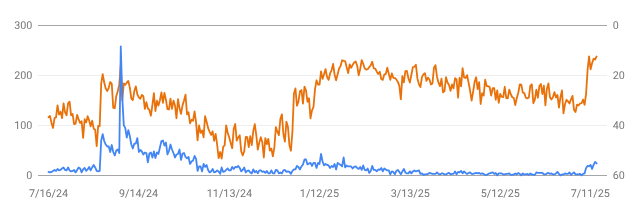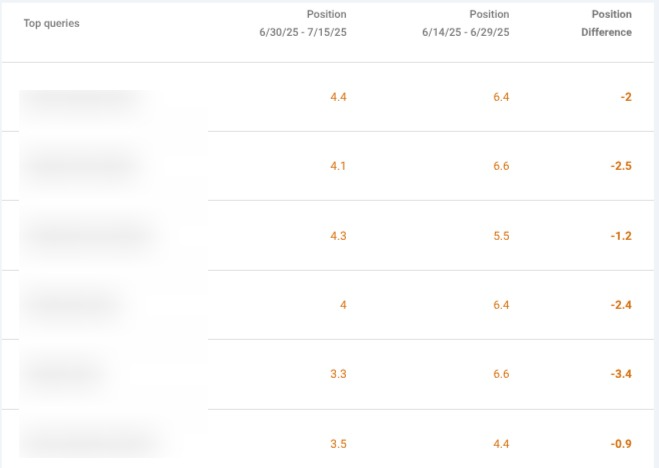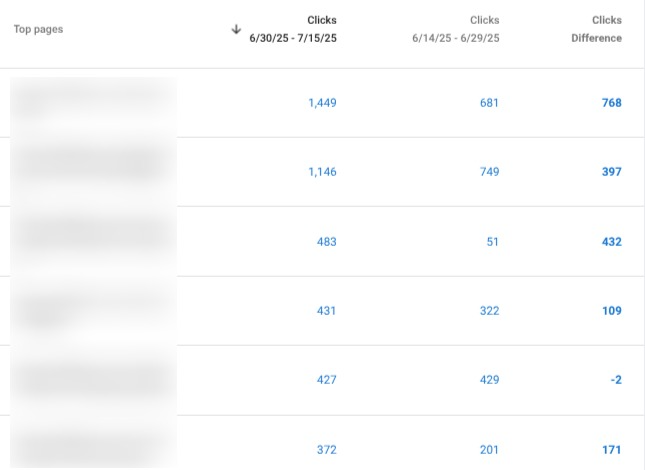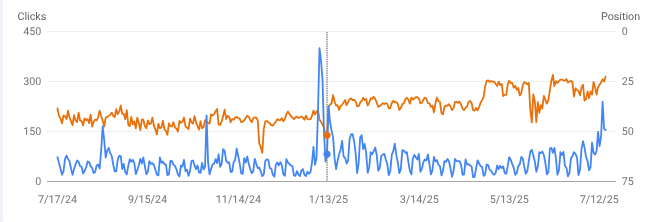Let’s take a look at some sites and pages that saw nice improvements following Google’s June 2025 Core Update. We’ll look at specific queries that improved and see if we can determine why Google’s new systems found them helpful.
Is MUVERA behind the June core update changes?
Updated Aug 5, 2025: I previously speculated that Google’s new breakthrough in vector search called MUVERA will help Google do better at finding truly helpful content on pages. MUVERA allows Google to do vector search that is as accurate as multi-vector search and as fast as single-vector search. Google spokesperson Gary Illyes recently said that he could not confirm that Google is using MUVERA in Search, but rather, "we might have something like it." This makes sense actually! When the MUVERA announcement came out I told a few people that I thought Google Search already worked like this. I think it makes sense that Google can convert a query into multiple vectors, and use multiple vectors to understand content and then use vector search techniques to get better and better at finding content that truly is likely to meet the searcher's needs.
The point of the June Core Update
Google told us that this update was designed to “better surface relevant, satisfying content for searchers from all types of sites,” so let’s see if that’s true!
The June Core update was favourable to many smaller sites. Sites that improved had pages with super helpful content. They tended to go beyond the obvious answer. They often demonstrated first hand experience. They were well structured and easy to scan. They often included helpful visuals.Google told us they'd surface helpful content from all types of sites. I believe the June 2025 Core update marks the start of some significant changes in search where Google shifts further away from using traditional ranking signals and more towards using AI to identify content that's likely to be helpful.
Methodology
In GSC I compared Jun 30-July 15 to the previous period and looked for pages that improved. Then I found keywords that saw nice improvements in rankings and clicks. I did build a Gemini Gem to do this for me, but found it was faster for me to surface these within the GSC interface myself.
Historically I have manually tried to find pages that improved following and update and then gave my thoughts on why those pages would be seen as helpful. This time I used a new tool that I am creating that uses a number of Gemini prompts and also my own knowledge, stored in a vector database. I’ll share more about this tool in the months to come. I’m thoroughly enjoying building it with the help of the Gemini CLI.
About the sites you will see below. These sites are owned by amazing folks who have given me permission to monitor their GSC and share. Although I have permission to share about their content, I have anonymized information as I think it’s not fair for them to show their competitors what it is that they are doing to succeed. These sites are not direct clients of mine as I have NDA’s with most of those clients and can't share their GSC info, but they are all owned by folks who follow the recommendations I share in my newsletter and in articles like this.
Case #1 - Gaming advice
This site saw nice gains although still is not back to previous levels it achieved. Clicks are increasing nicely and many ranking positions have improved significantly. Still, it should be noted that this site is only getting a tiny number of clicks each day. Hopefully this improvement is the start of something good.

When looking at a page that has seen a nice uptick in clicks, we can see that since the June 2025 core update, the top keywords have all improved in rankings by a few positions.

My Gemini prompt gave me a large list of specific reasons why this page might be seen as helpful. I asked it to anonymize the result:
Here is a summary of why the page is helpful, with all specific keywords and identifying details anonymized. This page is highly effective because it thoroughly addresses a user's need for detailed information to complete a complex, multi-part task. It provides a master class in how to create a helpful guide.
- Comprehensive Information in Multiple Formats: The page provides a complete catalog of all relevant items. It presents this information in two distinct ways—a quick-reference table for users who need a brief overview, and a detailed, descriptive list for those seeking in-depth knowledge.
- Actionable, Practical Guidance: It moves beyond simply listing what is needed by providing specific, actionable instructions on where and how to acquire each item. This gives the user a clear roadmap for accomplishing their goal.
- Essential Visual Aids: The guide includes a clear and distinct image for every single item discussed. For a task that relies on quick visual recognition, this is a critical feature that directly supports the user's success.
- Clear and Efficient Navigation: The page is structured logically with clear headings and a clickable table of contents. This allows users to easily find the exact piece of information they are looking for without unnecessary scrolling.
- Establishes Authority and Trust: The page builds credibility by clearly showcasing the author's expertise and first-hand experience with the subject. This assures the user that the information is authoritative and reliable.
Summary: This page is exceptionally helpful because it provides a complete, visually-supported checklist of every required item alongside clear, actionable instructions on exactly where to find them in the game.
Case #2 - Baby Advice
Again, nice improvements were seen by this site and it appears that it is still improving further. Both clicks and keyword rankings have improved.

I looked at a page that saw a significant increase in clicks, found a top keyword that had improved rankings and asked my tool for thoughts on what was helpful about this page in meeting the needs of searchers who had searched for this phrase. Again, I’ve asked Gemini to rewrite this in a way so as to not give away the site or the keyword searched:
This page is highly helpful because it provides a comprehensive, well-structured, and empathetic guide to a specific child-rearing technique, addressing nearly all of a searcher's potential questions and concerns.
Explanation of Helpfulness A user searching for information on this particular method has several core needs:
- Understanding: What does this technique entail?
- Execution: How do I implement it? When is the right time to start?
- Validation: Is this technique effective? How long does it usually take?
- Problem-Solving: How do I handle different situations, like nighttime? What if it isn't working, or if my child has setbacks?
This page excels at meeting these needs through its thoughtful structure and detailed content.
- Meeting the Need to Understand and Execute: The page immediately defines the technique and provides a dedicated section explaining it in detail. It offers clear, actionable instructions in a "how-to" section, using a bolded, numbered list that is easy to follow. It also includes a crucial section on readiness signs and a practical planning guide, which even advises on when not to use this intensive method, adding a layer of responsible, real-world advice.
- Ease of Finding Information: The content is exceptionally well-organized. The author uses clear, question-based headings that mirror a parent's own questions (e.g., "Does [this technique] Work?"). This structure allows a searcher to quickly scan the page and navigate directly to the section that answers their specific question without having to read the entire article.
- Insightful and Unique Content: What makes this page particularly helpful is its depth and empathy. It goes beyond a simple instructional guide.
- Troubleshooting: It features robust sections on handling "regression" (setbacks) and what to do if the technique isn't succeeding. These sections normalize common frustrations and provide concrete, bulleted strategies, demonstrating a deep understanding of the user's potential challenges.
- Comprehensive FAQs: The extensive "Frequently Asked Questions" section at the end is a standout feature. It tackles nuanced questions about potential messes, related products, and developmental timelines. This format is perfect for users looking for quick, direct answers.
- Realistic Expectations: The page does an excellent job of setting realistic expectations. It clarifies that mastering the skill during the day and at night are different milestones and gives parents permission to adapt the method for different situations. This kind of reassuring advice is invaluable to a stressed parent.
In essence, the page serves as a complete A-to-Z guide for this specific method. It not only explains the "what" and "how" but also provides the "what if" and "what's next," making it a one-stop, authoritative resource. Summary of Why This Page is Helpful
- Comprehensive Guide: The page covers the technique from start to finish, including a clear definition, signs of readiness, a step-by-step plan, and guidance on what to do after the initial phase.
- Easy to Scan: Excellent use of headings, bolded text, and lists allows users to quickly find answers to their specific questions without reading the whole page.
- Extensive Troubleshooting: The article provides unique and insightful advice for common problems, with dedicated sections for handling setbacks and what to do if the method isn't working.
- Detailed FAQ Section: A robust FAQ section directly addresses numerous secondary questions about potential challenges, related tools, and developmental timelines, adding significant value.
- Sets Realistic Expectations: The content is empathetic, normalizing common struggles and offering reassuring, practical advice that helps reduce parental stress.
Case #3: A site about learning a new language
This is a fascinating case because really, if someone wants to learn a new language, AI does a really good job here. You’d think websites would be less necessary. Yet, Google thinks this site is quite helpful. I agree!

Let’s look at a page that increased from 88 clicks in the two week period before the June Core update to a whopping 768 clicks in the two weeks following. The page describes how to use a particular word in this language.
This page is exceptionally helpful because it understands the true intent behind a query for a foreign language phrase. It recognizes that the searcher isn't just looking for a direct translation, but for the right words to use in a specific social context to achieve a desired effect. It delivers a masterclass in nuance, grammar, and cultural appropriateness.
Explanation of Helpfulness A user with this type of query, typically a language learner, has a primary need for a word, but more important secondary needs:
- What are the different ways to express this idea?
- What is the difference in meaning and feeling between them?
- How do I use them correctly in a sentence?
- How do I avoid sounding awkward or offensive?
This page meets these needs perfectly.
- Goes Beyond a Simple Translation: Instead of providing just one or two words, the page offers a numbered list of many different options. This immediately signals to the user that they will receive a comprehensive answer that covers a wide array of choices, from common terms to informal slang.
- Provides Crucial Context and Nuance: This is the page's greatest strength. For each option on the list, it explains the specific connotation (e.g., if a term is formal, distant, friendly, or intensely personal). It provides vital regional context, warning when a word might have a negative meaning in certain countries. This level of detail is exactly what a language learner needs to navigate real-world conversations successfully and avoid social blunders.
- Actionable Grammatical Guidance: The page doesn't just list words; it teaches the user how to deploy them. For nearly every term, it provides a simple formula for sentence construction, followed by clear example sentences with translations. It also explains fundamental grammatical rules of the target language (such as the difference between two verbs that both mean "to be"), which is invaluable information that directly impacts the meaning of the phrase.
- Expertise and Clear Structure: The content is attributed to an author with stated credentials as an experienced language teacher, which adds a strong signal of trust and authority. The numbered list format makes the extensive information easy to digest and allows the user to quickly compare different options to find the perfect one for their specific situation.
Summary of Why This Page is Helpful
- Comprehensive List of Options: The page provides a wide array of different words and phrases to express a single idea, going far beyond a simple dictionary answer.
- Essential Social and Cultural Context: It expertly explains the nuance, formality, and emotional weight of each term, including critical warnings about slang and regional differences.
- Clear Grammatical Instruction: For each term, it provides simple formulas and practical example sentences, showing the user exactly how to use the words correctly.
- Explains Key Language Concepts: It teaches fundamental grammar rules of the target language that are critical for learners to grasp in order to convey the correct meaning.
- Highly Scannable Format: The numbered list structure allows users to easily scan the content and compare the different options available to them.
Case #4: Health and wellness site
Woh, look at this!

These are some impressive post-core update stats.

It’s not just one page driving this increase. Most, but not all, are seeing nice increases in clicks:

Let’s look specifically at a page that reviews a category of beauty products. For the query I reviewed, there is an AIO. This site is not featured in the AIO, but they jumped from ranking at the bottom of page one to ranking #1 underneath the AIO.
It’s super helpful.
This page is extremely helpful because it's a comprehensive, trustworthy, and experience-driven guide that perfectly matches a user's need for product recommendations that satisfy two distinct criteria: one related to ingredient safety and another related to a specific personal need. Explanation of Helpfulness A user with this type of query isn't just looking for a shopping list. They are looking for trusted advice that addresses their health concerns about product composition while also solving a specific practical challenge. This page excels by addressing all facets of this dual-intent query.
- Establishes Authenticity and Trust: The title immediately signals that the content is based on real-world testing of numerous products. The author begins with a personal story about their own struggles with the specific challenge at hand, creating a relatable connection. The inclusion of a compelling before-and-after photo provides powerful visual proof that their methods and recommended products are effective.
- Educates Beyond Just Products: The page adds significant value by empowering the reader with knowledge.
- Ingredient Guidance: It provides a clear, actionable list of undesirable ingredients to avoid, helping the user make informed decisions for any future purchase.
- Best Practices: It offers general tips on technique related to the specific use case, acknowledging that great results come from more than just buying the right items. This holistic approach is incredibly useful.
- Detailed and Honest Reviews: The core of the page's helpfulness lies in the individual product reviews. For each product, the author provides:
- A clear photo, price, and the manufacturer's description.
- A personal "My take" section. This is where the real value is. The author gives specific, honest feedback on their experience with the product's scent, texture, performance, and even the usability of the packaging. This is the kind of detail that users can't get from a standard retail page.
- Caters to Diverse Needs: The author thoughtfully curates the list to meet various user priorities. A summary box at the top highlights winners for different categories like "Most Affordable" and "Best for [a specific goal]." The list includes products available at big-box stores and options suited for different variations of the user's need. This shows a deep understanding of the different circumstances a searcher might have.
- Transparency Builds Credibility: The author isn't afraid to point out flaws. They note when companies have incomplete ingredient disclosures and even explain why certain products from an otherwise good brand didn't make the final list. This level of transparency makes the positive recommendations that much more believable and trustworthy.
Summary of Why This Page is Helpful
- First-Hand Experience: The page is based on personal testing of numerous products, and the author's before-and-after photo provides authentic proof of effectiveness.
- Empowers the User: It educates readers with a list of undesirable ingredients to avoid and provides general best practices, adding value beyond just product links.
- Detailed, Honest Reviews: Each review includes specific, personal feedback on performance, scent, feel, and packaging, giving the user a true sense of the product.
- Caters to Various Needs: The recommendations include options for different budgets, specific performance goals, and availability at common retailers.
- Builds Trust Through Transparency: The author builds credibility by being honest about the potential downsides of certain products, such as incomplete ingredient disclosures.
Case #5: mariehaynes.com
Oh yeah, I don’t have to anonymize this one! My own site saw a nice boost with this update.

Let’s see what my tool says about my page on the query fan-out technique which saw a nice increase by a position or two in most keyword rankings.
This page is exceptionally helpful for the query "query fan out" because it's a timely, expert-led explanation of a new and technical industry term, written specifically for the audience most likely to search for it (SEO professionals and digital marketers). Explanation of Helpfulness A user searching for a technical term like "query fan out" has several core needs: a clear definition, context for its use, examples of it in action, and an understanding of its practical implications. This page masterfully addresses all of these needs.
- Authoritative and Credible Source: The page is written by Dr. Marie Haynes, a widely recognized and highly respected expert in the SEO industry. Her name alone signals to the searcher that the information will be accurate, insightful, and trustworthy. The author bio and the mention of speaking directly with a Google engineer at I/O reinforce this high level of E-E-A-T (Experience, Expertise, Authoritativeness, and Trust).
- Clear, Immediate Definition: The article immediately answers the core question in the very first paragraph, providing a concise and easy-to-understand definition of "query fan-out." It doesn't bury the lede, respecting the user's time and meeting their primary need instantly.
- Excellent Use of Examples and Visuals: The page's most effective feature is its use of concrete, side-by-side examples. By showing the search results for the same query in both "Traditional Search" and "AI Mode," complete with screenshots and a breakdown of the different websites cited, the author makes an abstract concept tangible. This visual comparison is far more powerful than a simple text explanation.
- Practical Implications and Actionable Advice: The page correctly anticipates that the searcher wants to know "What does this mean for me?" It includes dedicated sections like "How query fan-out impacts search rankings" and "How do we optimize for AI mode?". It translates the technical concept into practical implications and provides a clear, bulleted list of actionable strategies, such as creating comprehensive content hubs and thoroughly understanding user intent.
- Insightful, Unique Details: The article contains information that likely can't be found elsewhere, such as the tidbit that "a special version of Gemini is used to generate the query fan-out," a detail attributed to a Google engineer. This kind of unique insight demonstrates deep expertise and makes the page a go-to resource.
Summary of Why This Page is Helpful
- Written by a Top Industry Expert: The author, Marie Haynes, is a highly credible and authoritative figure, making the information exceptionally trustworthy.
- Provides a Direct Definition: The page immediately defines the term "query fan-out" in the opening paragraph, satisfying the user's primary need.
- Uses Powerful Visual Examples: It uses clear, side-by-side screenshot comparisons to effectively illustrate the difference between traditional search and the new method.
- Explains the "So What?": The article goes beyond definition to explain the practical implications for SEOs and how it impacts website rankings.
- Offers Actionable Optimization Tips: It provides a clear, bulleted list of strategies that professionals can use to adapt to this new search dynamic.
- Contains Unique Insights: The page includes unique details learned directly from sources at Google, offering information that is not widely available.
Summarizing all of the helpful stuff
I gave all of this information to Gemini 2.5 Pro and asked it to summarize what likely made these pages helpful and give suggestions we can all use when we try to improve our pages.
Here is a summary of the common themes found in helpful pages, followed by actionable advice for creators. Across the board, pages that Google's new systems deem helpful are those that completely satisfy a user's needs by providing comprehensive, trustworthy, and highly practical content within an excellent user experience. These pages don't just answer a question; they go deeper by offering actionable steps, troubleshooting for potential problems, and crucial context that a user might not have known they needed. They build trust by demonstrating clear first-hand experience and expertise on the topic, often through personal anecdotes, detailed testing, and unique insights. Structurally, they are easy to navigate and scan, using clear headings, lists, and helpful visuals like original images and charts to make complex information digestible. Ultimately, a helpful page anticipates and thoroughly addresses all of the user's likely follow-up questions, making it a complete and authoritative one-stop resource that eliminates the need for the user to return to the search results. Here is actionable advice on how to create content that Google and users are likely to find helpful:
- Go Beyond the Obvious Answer: Don't just provide a simple definition or a single method. Anticipate all the follow-up questions a user might have and answer them. Cover the "what if," "how to," "why," and "what's next."
- Demonstrate First-Hand Experience: Show, don't just tell. Use original photos and videos of you using a product or performing a task. Share your personal story, your honest opinions, and the results of your own testing. This is crucial for building trust.
- Prioritize Structure and Scannability: Make your content easy to consume. Use clear headings, subheadings, short paragraphs, bolded text, and bulleted or numbered lists. Include a table of contents for longer articles to help users find the exact section they need.
- Include Truly Helpful Visuals: Use images, screenshots, charts, and graphics that clarify your points and help the user understand the content. For a "how-to" guide, show pictures of each step. For a product review, show the product in use.
- Offer Actionable, Practical Advice: Give your users a clear roadmap. Provide step-by-step instructions, checklists, and practical tips that help them solve a problem or accomplish a task.
- Include Troubleshooting and FAQs: Address common problems, potential setbacks, and frequently asked questions. Showing users how to avoid or fix mistakes demonstrates a deep level of expertise and empathy for their journey.
- Aim to Be a Complete, One-Stop Resource: Your goal should be to create a page so comprehensive and satisfying that the user has no reason to hit the back button. Cover the topic in its entirety, linking to other relevant resources on your site to demonstrate topical authority.
But wait, why didn’t Google think these pages were helpful before?
We have to remember that Google has new ways of looking at the content on pages now.
We know from the DOJ vs Google trials that Google uses traditional ranking systems to initially get results. Then AI systems, including RankBrain are used to re-rank those results. Those systems use vector search.
Prior to Google’s invention of the MUVERA technique, the vector search would match the query with documents whose vector indicated they covered a specific topic. Other signals such as links (recommendations from others) or clicks could help Google approximate which of those pages were likely to be good examples to show a searcher. Now, the search can determine much more about the specific details within a document. This means that Google got better at finding content that is likely to be helpful.
Remember how Google’s announcement of the core update said the June Core update got better at surfacing helpful and satisfying content from all types of sites? I think this was another advancement in which traditional signals for SEO like links, authoritativeness, and click patterns became less important than the system’s assessment of the entirety of the content on a page.
Something cool about this post
Yesterday ChatGPT Agent came out. I asked it to take my Google Doc of this post and publish it in WordPress. It did not do a perfect job, but it did successfully download all of the images, optimize them and put them in my WordPress media section. I had to copy and paste the text of the article myself. Still, we are getting closer to the day when machines do our menial work and we are freed up to create!
I'll be sharing more about ChatGPTAgent, and also more about my new content improving agents that will help you create helpful content in my newsletter:



Comments are closed.